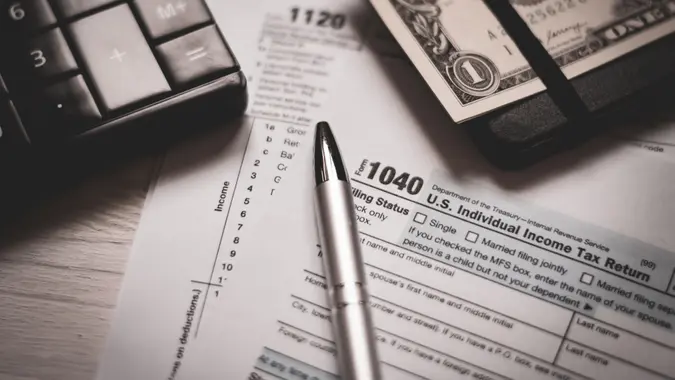Advertiser Disclosure
GOBankingRates works with many financial advertisers to showcase their products and services to our audiences. These brands compensate us to advertise their products in ads across our site. This compensation may impact how and where products appear on this site. We are not a comparison-tool and these offers do not represent all available deposit, investment, loan or credit products.
The Common Mistakes People Make When Filing a Tax Extension
 Written by
Heather Taylor
Written by
Heather Taylor
 Edited by
Levi Leidy
Edited by
Levi Leidy

Commitment to Our Readers
GOBankingRates' editorial team is committed to bringing you unbiased reviews and information. We use data-driven methodologies to evaluate financial products and services - our reviews and ratings are not influenced by advertisers. You can read more about our editorial guidelines and our products and services review methodology.

20 YearsHelping You Live Richer

Reviewed by Experts

Trusted by Millions of Readers
If you plan to file a tax extension on your return this year, you’ll want to be careful that you do not make any filing errors. Some mistakes are pretty easy to make while others may be less obvious and need to be double-checked.
Thinking an Extension Means More Time To Pay
The biggest mistake people make when filing a tax extension is understanding what it means to file an extension.
Mark Steber, chief tax information officer at Jackson Hewitt, said that usually people think filing an extension means there’s more time to file and pay. The reality is it’s only more time to file. If taxpayers have a balance due on Tax Day, they have to pay it.
Not Filing a State Extension
In addition to filing an extension on your federal tax return, you must also file your state return. Each state has different rules about filing a state tax extension. States may also have different tax deadlines than federal tax deadlines. Rob Cordasco, CPA and founder of Cordasco & Company, PC, recommends reviewing your state extension filing rules.
“Although most states accept the IRS extension, some do not conform and require you to separately file an extension with the state on their predetermined forms,” Cordasco said.
Filing the Wrong Extension Form
Do you know the difference between the two major tax extension forms? Logan Allec, CPA and owner of Choice Tax Relief, said the two forms are Form 4868 (for individuals) and Form 7004 (for businesses).
If you’re using tax software to file your extension, Allec said your software will automatically know which form to use. Individuals using paper filing must use Form 4868. Do not accidentally file using Form 7004.
“It may seem obvious that you should use the form that has the word individual in its title rather than the word business, but stranger things have happened with tax forms,” Allec said.
Using Incorrect Personal Information
Did your name or address change since your last communication with the IRS? Armine Alajian, CPA and founder of Alajian Group, said that if any of your personal information has changed, the IRS may not be able to match your tax information to the extension application information. Submit Form 8822 to the IRS to declare any changes in personal information. Otherwise, your extension is likely to be rejected.
What about other types of incorrect information, like misspellings, inaccurate Social Security numbers or claiming the wrong filing status? Alajian said in the event of a rejection due to out-of-date information, the IRS will grant you five days to correct any errors with your request and re-file.
Not Obtaining Proof of a Timely Filed Extension
After filing, you’ll need to obtain proof that the extension was filed in a timely manner.
Cordasco said, where possible, the extension should be electronically filed. This gives you an electronic confirmation of the IRS receipt and acceptance.
If you need to mail the extension form, Cordasco said to send the form to the IRS via certified mail. This provides you with proof of when the form was sent to the IRS and the receipt.
Why do you need proof that your tax extension was filed on time? “This information will be critical if there is an error on the form. It will show reasonable cause for your argument on why penalties should not apply,” Cordasco said. “We would hope to not have this discussion, but it will be the only course of action for an incorrectly filed extension.”
Forgetting Your Social Security Number in the Check’s Memo Section
If you need to pay by check for your taxes, you must write down your Social Security number in the memo section of your check. The same rule applies to payments made for tax return extensions.
Mark Puzdrak, owner of Puzdrak CPA, said one of the biggest mistakes people make is not including the Social Security number of the primary account holder in the check’s memo section when they mail in the extension payment.
“The IRS uses the primary taxpayer — the taxpayer listed first — as the account holder,” Puzdrak said. “If the secondary taxpayer writes the check and writes in their Social Security number on the memo line, there is a chance that the IRS will not match up that payment to the joint account with their spouse.”
What happens next is that the IRS will cash the check, but Puzdrak said the payment will float around in their system until someone, like the taxpayer or their CPA, reaches out and tells them to apply that payment to their account. The best way to clear up this situation is to contact the IRS and provide the agent with the correct information.
Filing a Tax Extension at the Last Minute
If you know you need a tax extension, do not put off filing for one.
“If you don’t file for an extension on or before the deadline, you’ll be facing a late filing penalty coupled with a late payment penalty if you owe money, on top of the interest tacked onto that amount,” Alajian said.
What’s the tax extension this year? The IRS said the filing deadline for submitting 2021 tax returns or an extension to file and pay taxes owed is Monday, April 18, 2022.
Share This Article:




You May Also Like

How To Get a Head Start on Your 2026 Tax Return in January -- Tax Experts Share 8 Moves
December 12, 2025
5 min Read


I'm a Tax Expert: 9 End-of-Year Tax Moves You Should Make Before Dec. 31
December 11, 2025
5 min Read

Financial Expert: Here's the Smartest Way Boomers Can Give Kids Tax-Free Money
December 10, 2025
5 min Read

I Asked ChatGPT What Would Happen If Billionaires Paid Taxes at the Same Rate as the Working Class
December 11, 2025
5 min Read

You're Probably Overpaying the IRS by $1,000 or More a Year: Here's How To Stop
December 10, 2025
5 min Read

Trump's Tax Promises for the Middle Class: How Much of Them Has He Fulfilled?
December 10, 2025
5 min Read

I Asked ChatGPT What Would Happen If Billionaires Paid Taxes at the Same Rate as the Average Texas Resident
December 09, 2025
5 min Read


I'm a Tax Expert: 5 Smart Moves To Prepare For Tax Changes Under Trump's Big Beautiful Bill
December 05, 2025
5 min Read


I Asked ChatGPT What Would Happen If Billionaires Paid Taxes at the Same Rate as the Average Hawaii Resident
November 26, 2025
5 min Read


Here's How the One Big Beautiful Bill Will Impact Tax Returns in Every State
November 25, 2025
5 min Read

Make your money work for you
Get the latest news on investing, money, and more with our free newsletter.
By subscribing, you agree to our Terms of Use and Privacy Policy. Unsubscribe at any time.


Thanks!
You're now subscribed to our newsletter.
Check your inbox for more details.



Sending you timely financial stories that you can bank on.
Sign up for our daily newsletter for the latest financial news and trending topics.
For our full Privacy Policy, click here.
Looks like you're using an adblocker
Please disable your adblocker to enjoy the optimal web experience and access the quality content you appreciate from GOBankingRates.
- AdBlock / uBlock / Brave
- Click the ad blocker extension icon to the right of the address bar
- Disable on this site
- Refresh the page
- Firefox / Edge / DuckDuckGo
- Click on the icon to the left of the address bar
- Disable Tracking Protection
- Refresh the page
- Ghostery
- Click the blue ghost icon to the right of the address bar
- Disable Ad-Blocking, Anti-Tracking, and Never-Consent
- Refresh the page



